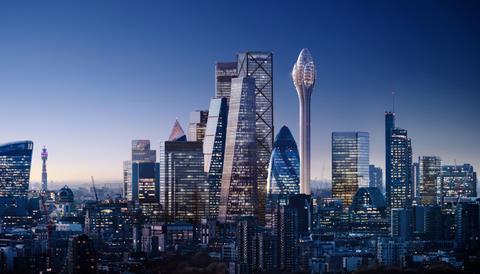School and community groups would not have free access to key elements of Fosters’ visitor attraction
Lawyers for the mayor of London have urged the government to reject the controversial Tulip tower on the grounds that the Foster & Partners scheme would exclude visiting children and community groups from using key elements of the attraction.
An educational centre within the 305m tower earmarked for a site within the City of London’s eastern cluster of skyscrapers has been cited by developer Bury Street Properties as one of its primary public benefits.

The building consists of a 12-storey viewing area at the top of a slender concrete shaft, or stem, rising from the plaza which surrounds the Gherkin, also designed by Foster and owned by Bury Street.
Visiting school and community groups would have free access to the educational space, located on the lowest floor of the educational area, but would not have access to several key features as paying visitors, including the glass slides and rotating gondolas fixed to the outside of the building.
Lawyer Hereward Phillpot QC, who is representing the mayor’s office, said in his closing submission to a virtual public inquiry into the scheme that the position of the educational centre at the lowest level of usable space within the viewing platform “reflects the building’s socially stratified nature”.
He added the restriction of the attraction’s “most exciting elements”, the slides and the gondolas, to paying customers “would inevitably reinforce the sense that the experience of the school children and community groups is an inferior one compared to those who can afford to pay to use the areas above”.
He also cited as evidence for a “marked lack of enthusiasm” the fact that only three of the 74 schools invited to a beneficiaries’ event sent representatives.
His remarks came on the final day of the inquiry into the scheme. Bury Street Properties’ owner, billionaire financier Jacob J Safra, appealed after Sadiq Khan rejected the proposals last summer, overruling the planning consent granted by the City Corporation three months previously.
Historic England has also objected to the scheme, with its lawyer, Scott Lyness, telling the inquiry in his closing submission that the tower would cause “considerable permanent harm” to views of the nearby Tower of London.
Lyness said the backers of the proposals had sought to “invest this building with meaning and merit that on scrutiny it does not deserve, a building which, in this location, driven by attention-seeking aspirations, its inherent need for striking prominence and distinct landmark status cannot plausibly be described as causing only a small degree of detriment to the highly vulnerable setting of the Tower of London, one of the world’s great historic monuments.”
The Tulip’s location on the eastern edge of the City’s skyscraper cluster, which includes the Cheesegrater and the recently completed 22 Bishopsgate, pulls the cluster “aggressively into the very area which has been identified as most vulnerable for conserving the significance of the tower”, he added.
But Neil Cameron QC, counsel for the City, said planners had given “great weight” to the heritage impacts of the tower when granting its approval in April 2019, adding that the corporation’s opinion “should command respect”.
He went on to say that the “very high quality” scheme would offer “significant educational and community benefits and public realm improvements”, and would “extend an invitation to a wider range of people to enjoy the wonder of the cluster and a view over all London has to offer”.
Bury Street Properties’ barrister Russell Harris QC also defended the tower, saying it was “elegant and has a gentle gracefulness of form, which is high, exciting and exuberant of use, but which also maintains its essential architectural calmness, authority and authenticity”.
Last month, the scheme’s lead architect Robert Harrison rejected criticisms quoted by Harris that the tower’s design resembled a “watchtower in a prison camp”.
The final decision is to be made by secretary of state Robert Jenrick – although no time frame has been announced.
















No comments yet